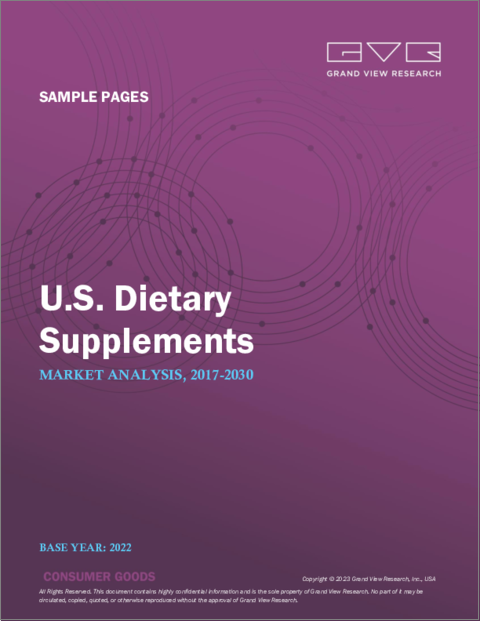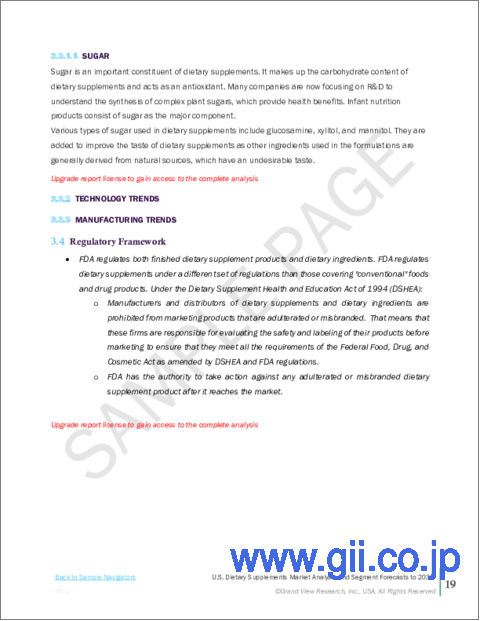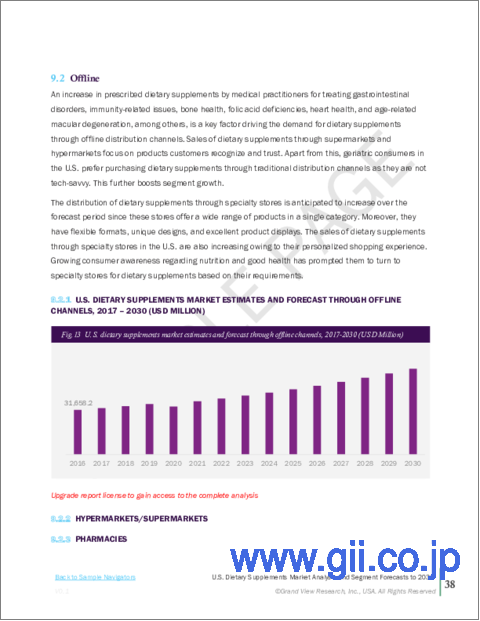|
|
市場調査レポート
商品コード
1268776
米国の栄養補助食品の市場規模、シェア、動向分析レポート:タイプ別(OTC、処方)、成分別、形態別、用途別、最終用途別、流通チャネル別、セグメント別予測、2023年~2030年U.S. Dietary Supplements Market Size, Share & Trends Analysis Report By Type (OTC, Prescribed), By Ingredient, By Form, By Application, By End-user, By Distribution Channel, And Segment Forecasts, 2023 - 2030 |
||||||
|
● お客様のご希望に応じて、既存データの加工や未掲載情報(例:国別セグメント)の追加などの対応が可能です。 詳細はお問い合わせください。 |
|||||||
| 米国の栄養補助食品の市場規模、シェア、動向分析レポート:タイプ別(OTC、処方)、成分別、形態別、用途別、最終用途別、流通チャネル別、セグメント別予測、2023年~2030年 |
|
出版日: 2023年04月06日
発行: Grand View Research
ページ情報: 英文 141 Pages
納期: 2~10営業日
|
- 全表示
- 概要
- 図表
- 目次
米国の栄養補助食品市場の成長と動向:
Grand View Research, Inc.の最新レポートによると、米国の栄養補助食品市場規模は、2023年から2030年にかけて5.7%のCAGRを記録し、2030年には789億4,000万米ドルに達すると予想されています。
この需要は、高齢化社会、予防ヘルスケアに対する意識の高まり、スポーツ栄養サプリメントの需要の高まりなど、いくつかの要因によってもたらされると予測されています。
さらに、米国では、自己管理の傾向が栄養補助食品の需要を促進しています。消費者は、自分の健康管理に積極的になり、食生活を強化し最適な健康を維持する方法としてサプリメントに目を向けています。消費者は自分の健康に責任を持つようになり、健康とウェルネスを向上させるために自然療法や代替療法を求めるようになってきています。
栄養補助食品は、栄養価や薬効が高く、重大な副作用がなく安全に摂取できることから、ここ数年、絶大な人気と注目を浴びています。また、栄養補助食品は、慢性および急性の健康問題の管理および予防において、急速に医薬品に取って代わろうとしています。これらの製品は、治療や予防の効果を持つ治療薬として十分な可能性を持っています。これらの製品は一般に、処方箋を必要とせず、市販されているため、一般消費者が容易に入手することができます。
健康への関心が高まるにつれ、消費者はより良い食事をし、より健康的な生活を送るようになりました。しかし、多忙なスケジュールの中、健康的で栄養価の高い食事を作る時間はほとんどなく、消費者は必要な栄養素の不十分な摂取を補うために栄養補助食品に頼っています。これとは別に、個人に合わせた栄養摂取の動向の高まりと消費者の消費力の向上が、製品需要に好影響を与えると予想されます。米国の消費者の間では、より優れた栄養価を持つ製品にプレミアム価格を支払う意欲が高まっています。さらに、より多くの消費者を惹きつけるために、目を引くパッケージや天然成分を使用する企業の傾向が強まっています。このことは、同国における製品の普及を引き続き促進するものと思われます。
ナノカプセル化およびマイクロカプセル化技術は、成分の放出制御と最小限の利用により、過去数年間に人気を博してきました。飲食品の強化にカプセル化技術が導入され、応用されることで、スポーツ栄養成分の成長余地は計り知れないです。さらに、合成成分による健康への懸念が高まる中、天然由来成分への需要が高まっており、スポーツ栄養業界におけるハーブサプリメントの浸透を促進すると期待されています。
多忙な勤務体系や不健康な食習慣に起因する健康への懸念が高まり、消費者の健康とフィットネスへの関心が高まっています。また、国内における肥満の増加により、人々はより多くの運動をするようになりました。このような消費者の様々な運動への参加の増加や、国際的・国内的なスポーツイベントの増加により、スポーツ栄養補助食品の需要が高まっています。
米国の栄養補助食品市場レポートハイライト:
- 成分は、ビタミン、植物、ミネラル、タンパク質・アミノ酸、繊維・特殊炭水化物、オメガ脂肪酸、プロバイオティクス、その他に分類されます。2022年には、ビタミン分野が30.11%以上の収益シェアを獲得し、市場を独占しました。ビタミンは、食事だけでは必要な栄養素を摂りきれない人たちの間で人気の栄養補助食品です。さらに、A、B、C、Dなどの特定のビタミンは、免疫、骨の健康、脳機能に関連する健康効果が期待できるため、社会人やスポーツ選手の間でより人気が高まると予想されます。
- 市場は形態別、錠剤、カプセル、ソフトジェル、粉末、グミ、液体、その他に分類されます。カプセル剤は、有効成分を光、湿気、酸素から保護し、効能と品質を長期にわたって維持し、保存期間を延ばすことができる利便性とデザイン性により、2022年の収益シェアは30.30%で市場を独占し、予測期間中もその優位性を保つと予想されます。
- 用途別では、健康志向の高まりにより、一般健康分野が2022年に23.66%の収益シェアを獲得し、市場を独占しました。この動向は、消費者の食生活が変化し、多くの人が全体的な健康と幸福を維持するために予防的なヘルスケアを求めるようになったことが主因です。
- 最終用途別では、社会人やスポーツ選手の間でバランスのとれた食生活を送ることの重要性に対する意識が高まり、その結果、健康全般をサポートする栄養補助食品への需要が高まっていることから、2022年には成人が46.23%の売上シェアを獲得しました。
- タイプ別では、OTC(Over-the-Counter)セグメントが2022年に85.17%の売上シェアを獲得し、市場を独占しました。OTCサプリメントは処方箋のサプリメントよりも手頃な価格で購入できることが多く、消費者にとって魅力的な選択肢となっています。
- 流通チャネル別では、オフライン流通チャネルが2022年に78.13%の収益シェアを獲得し、市場を独占しています。胃腸障害、免疫関連問題、骨の健康、葉酸不足、心臓の健康、加齢黄斑変性などの治療のために医療従事者が処方する栄養補助食品の増加は、オフラインの流通チャネルを通じた栄養補助食品の需要を促進する主要因です。
目次
第1章 調査手法と範囲
- 市場セグメンテーションと範囲
- 調査手法
- 仮定
- 情報調達
- 購入したデータベース
- GVRの内部データベース
- 二次情報
- 第三者の視点
- 1次調査
- 情報分析およびデータ分析モデル
- データソースのリスト
第2章 エグゼクティブサマリー
- 市場のスナップショット
- セグメント別の洞察
- 競合考察
第3章 米国の栄養補助食品市場:業界の展望
- 市場系統の見通し
- 親市場の見通し
- 栄養補助食品市場
- 関連市場の見通し
- プロテインサプリメント
- 親市場の見通し
- 普及と成長の見通しマッピング
- 業界のバリューチェーン分析
- 原材料の動向
- 砂糖
- クエン酸
- 大豆
- 製造業の動向
- 技術動向
- 原材料の動向
- 技術概要
- 規制の枠組み
- 米国の栄養補助食品市場-市場力学
- 市場促進要因の分析
- 医薬品から栄養補助食品への移行
- 栄養、健康、ウェルネスに関する消費者の意識の向上
- スポーツ栄養補助食品の需要の高まり
- 市場抑制要因分析
- 機能性食品別代替の脅威
- オーガニック食品からの代替の脅威
- 業界の課題
- 高い原料開発コストと厳しい政府規制
- 市場促進要因の分析
- ビジネス環境分析:
- 米国の栄養補助食品市場:ポーターの分析
- 米国の栄養補助食品市場:PESTEL分析
- 主要取引と戦略的提携の分析
- 市場参入戦略
- 消費者の洞察
第4章 米国の栄養補助食品市場:成分推定・動向分析
- 成分変動分析と市場シェア、2022年と2030年
- 成分別
- ビタミン
- ボタニカル
- ミネラル
- タンパク質とアミノ酸
- 繊維と特殊炭水化物
- オメガ脂肪酸
- プロバイオティクス
- その他
第5章 米国の栄養補助食品市場:形態の推定・動向分析
- 形態変動分析と市場シェア、2022年と2030年
- 形態別
- タブレット
- カプセル
- ソフトジェル
- 粉末
- グミ
- 液体
- その他
第6章 米国の栄養補助食品市場:用途の推定・動向分析
- 用途別、2017~2030年
- エネルギーと体重の管理
- 一般的な健康
- 骨と関節の健康
- 胃腸の健康
- 免疫
- 心臓の健康
- 抗がん剤
- 糖尿病
- 肺のデトックス/浄化
- 肌/髪/爪
- 性的健康
- 脳/メンタルヘルス
- 不眠症
- 閉経
- 老化防止
- 出生前の健康
- その他
第7章 米国の栄養補助食品市場:エンドユーザーの推定・動向分析
- エンドユーザーの変動分析と市場シェア、2022年と2030年
- 最終用途別、2017~2030年
- 大人
- 大人別、2017~2030年
- 労働・肉体労働成人
- 座り仕事をする成人
- スポーツ/フィットネス/アスリート
- その他
- 高齢者向け
- 妊娠中の女性
- 子供
- 幼児
- 大人
第8章 米国の栄養補助食品市場:種類の推定・動向分析
- タイプの変動分析と市場シェア、2022年と2030年
- タイプ別、2017~2030年
- OTC
- 処方
第9章 米国の栄養補助食品市場:流通チャネルの推定・動向分析
- 流通チャネルの変動分析と市場シェア、2022年と2030年
- 流通チャネル別、2017~2030年
- オフライン
- タイプ別、2017~2030年
- スーパーマーケット/ハイパーマーケット
- 薬局
- 専門店
- 開業医
- その他
- オンライン
- オフライン
第10章 競合情勢
- 主要企業、最近の動向、および業界への影響
- 主要な企業/競合の分類(主要なイノベーター、市場リーダー、新興企業)
- 糖尿病健康補助食品を提供する企業のリスト
- メンタルヘルスサプリメントを提供する企業のリスト
- ベンダー情勢
- List of key distributors and channel partners
- key potential customers
- 公開会社
- 企業の市場シェア分析(公開会社)
- 競合ダッシュボード分析
- 市場の差別化要因
- 市場ランキング分析
- 非公開会社
- 主要な新興企業のリスト(糖尿病とメンタルヘルスのサプリメント)
- 地理的存在
- 企業の市況分析
- 企業プロファイル
- 財務実績
- 製品のベンチマーク
- 戦略的取り組み
List of Tables
- Table 1 U.S. Dietary Supplements Market Revenue Estimates and Forecasts, By Ingredient, 2017 - 2030 (USD Million)
- Table 2 U.S. Dietary Supplements Market Revenue Estimates and Forecast, By Form, 2017 - 2030 (USD Million)
- Table 3 U.S. Dietary Supplements Market Revenue Estimates and Forecast, By Application, 2017 - 2030 (USD Million)
- Table 4 U.S. Dietary Supplements Market Revenue Estimates and Forecast, By End User, 2017 - 2030 (USD Million)
- Table 5 U.S. dietary supplements market estimates and forecasts, by adults, 2017 - 2030 (USD Million)
- Table 6 U.S. Dietary Supplements Market Revenue Estimates and Forecast, By Type, 2017 - 2030 (USD Million)
- Table 7 U.S. Dietary Supplements Market Revenue Estimates and Forecast, By Distribution Channel, 2017 - 2030 (USD Million)
- Table 8 Offline U.S. dietary supplements market estimates and forecasts, by type, 2017 - 2030 (USD Million)
- Table 9 Company Market Share, 2021
List of Figures
- Fig. 1 U.S. dietary supplements market segmentation & scope
- Fig. 2 Information procurement
- Fig. 3 Primary research pattern
- Fig. 4 Primary research process
- Fig. 5 Primary research approaches
- Fig. 6 U.S. dietary supplements market: Market snapshot
- Fig. 7 U.S. dietary supplements market: Segment outlook
- Fig. 8 U.S. dietary supplements market: Segment outlook
- Fig. 9 U.S. dietary supplements market: Segment outlook
- Fig. 10 U.S. dietary supplements market: Competitive outlook
- Fig. 11 U.S. dietary supplements market: Penetration & growth prospect mapping
- Fig. 12 U.S. dietary supplements market: Value chain analysis
- Fig. 13 Global sugar production, by country, 2021 (%)
- Fig. 14 Global sugar consumption, by country, 2021 (%)
- Fig. 15 Global citric acid production, by country, 2021 (%)
- Fig. 16 Global soybean production, by country, 2021 (%)
- Fig. 17 U.S. functional foods market, 2017-2030 (USD Billion)
- Fig. 18 U.S. agricultural area under organic agriculture, 2017 - 2030 (1000 ha)
- Fig. 19 U.S. dietary supplements market: Porter's analysis
- Fig. 20 U.S. dietary supplements market: PESTEL analysis
- Fig. 21 U.S. dietary supplements market, by ingredient: Key takeaways
- Fig. 22 U.S. Dietary Supplements Market, by Ingredient: Market Share, 2022 & 2030
- Fig. 23 Vitamins market estimates & forecasts, 2017 - 2030 (USD Million)
- Fig. 24 Botanicals market estimates & forecasts, 2017 - 2030 (USD Million)
- Fig. 25 Minerals market estimates & forecasts, 2017 - 2030 (USD Million)
- Fig. 26 Proteins & amino acids market estimates & forecasts, 2017 - 2030 (USD Million)
- Fig. 27 Fibers & specialty carbohydrates market estimates & forecasts, 2017 - 2030 (USD Million)
- Fig. 28 Omega fatty acids market estimates & forecasts, 2017 - 2030 (USD Million)
- Fig. 29 Probiotics market estimates & forecasts, 2017 - 2030 (USD Million)
- Fig. 30 Others market estimates & forecasts, 2017 - 2030 (USD Million)
- Fig. 31 U.S. Dietary Supplements Market, by Form: Key Takeaways
- Fig. 32 U.S. Dietary Supplements Market, by Form: Market Share, 2022 & 2030
- Fig. 33 Tablets market estimates & forecasts, 2017 - 2030 (USD Million)
- Fig. 34 Capsules market estimates & forecasts, 2017 - 2030 (USD Million)
- Fig. 35 Soft gels market estimates & forecasts, 2017 - 2030 (USD Million)
- Fig. 36 Powders market estimates & forecasts, 2017 - 2030 (USD Million)
- Fig. 37 Gummies market estimates & forecasts, 2017 - 2030 (USD Million)
- Fig. 38 Liquids market estimates & forecasts, 2017 - 2030 (USD Million)
- Fig. 39 Others market estimates & forecasts, 2017 - 2030 (USD Million)
- Fig. 40 Energy & weight management market estimates & forecasts, 2017 - 2030 (USD Million)
- Fig. 41 General health market estimates & forecasts, 2017 - 2030 (USD Million)
- Fig. 42 Bone & joint health market estimates & forecasts, 2017 - 2030 (USD Million)
- Fig. 43 Gastrointestinal health market estimates & forecasts, 2017 - 2030 (USD Million)
- Fig. 44 Immunity market estimates & forecasts, 2017 - 2030 (USD Million)
- Fig. 45 U.S. Dietary Supplements Market, by End User: Key Takeaways
- Fig. 46 U.S. Dietary Supplements Market, by End User: Market Share, 2022 & 2030
- Fig. 47 Adults market estimates & forecasts, 2017 - 2030 (USD Million)
- Fig. 48 Geriatric market estimates & forecasts, 2017 - 2030 (USD Million)
- Fig. 49 Pregnant Women market estimates & forecasts, 2017 - 2030 (USD Million)
- Fig. 50 Children market estimates & forecasts, 2017 - 2030 (USD Million)
- Fig. 51 Infants market estimates & forecasts, 2017 - 2030 (USD Million)
- Fig. 52 U.S. Dietary Supplements Market, by Type: Key Takeaways
- Fig. 53 U.S. Dietary Supplements Market, by Type: Market Share, 2022 & 2030
- Fig. 54 OTC market estimates & forecasts, 2017 - 2030 (USD Million)
- Fig. 55 Prescribed market estimates & forecasts, 2017 - 2030 (USD Million)
- Fig. 56 U.S. Dietary Supplements Market, by Distribution Channel: Key Takeaways
- Fig. 57 U.S. Dietary Supplements Market, by Distribution Channel: Market Share, 2022 & 2030
- Fig. 58 Offline market estimates & forecasts, 2017 - 2030 (USD Million)
- Fig. 59 Online market estimates & forecasts, 2017 - 2030 (USD Million)
- Fig. 60 U.S. dietary supplements market: Key Company/Competition Categorization
- Fig. 61 U.S. dietary supplements market: Company market share analysis (public companies)
- Fig. 62 Company market position analysis
U.S. Dietary Supplements Market Growth & Trends:
The U.S. dietary supplements market size is expected to reach USD 78.94 billion by 2030, registering a CAGR of 5.7% from 2023 to 2030, according to a new report by Grand View Research, Inc. The demand is anticipated to be driven by the several factors including the aging population, increasing awareness about preventive healthcare, and rising demand for the sports nutrition supplements.
Furthermore, the trend towards self-directed care is also driving demand for the dietary supplements in the U.S. Consumers, those are becoming more proactive in managing their health and are turning to supplements as a way to enhancement their diets and maintain optimal health. As consumers take more responsibility for their health, they are seeking out natural and alternative remedies to improve their health and wellness.
Nutraceutical supplements have received immense popularity and focus in the recent past owing to their nutritional and medicinal benefits, along with being safe for consumption without any significant side effects. Nutraceuticals are also quickly replacing pharmaceuticals in the management and prevention of chronic and acute health problems. These products have ample scope as therapeutic agents with curative and preventive properties. They are generally available over the counter, without requiring a prescription, making them easily accessible to the general public.
The rising health concerns have driven consumers to eat better and lead healthier lives. However, with busy schedules and little time to make healthy, nutritious meals, consumers are relying on dietary supplements to make up for the inadequate intake of the required nutrients. Apart from this, the growing trend of personalized nutrition and the increased spending power of the consumers are expected to have a positive impact on product demand. There is a rising willingness among consumers in the U.S. to pay a premium price for products with better nutritional value. Add to this the growing tendency of companies to use eye-catching packaging and natural ingredients to attract more consumers. This will continue to drive the product adoption in the country.
Nanoencapsulation and microencapsulation technologies have gained popularity during the past few years owing to the controlled release and minimum utilization of the ingredients. The introduction and application of encapsulation technologies in the fortification of food & beverage products offer sports nutrition ingredients immense scope for the growth. Furthermore, ascending demand for the naturally derived ingredients in light of increasing health concerns related to synthetic ingredients is expected to fuel the penetration of herbal supplements in the sports nutrition industry.
Mounting health concerns stemming from hectic work schedules and unhealthy eating habits have increased consumer focus on health and fitness. Rising cases of obesity in the country have also driven people to exercise more. This rising participation of consumers in various physical activities, coupled with increasing international and national sporting events, has propelled demand for the sports nutritional supplements.
U.S. Dietary Supplements Market Report Highlights:
- Based on ingredient, the market is segmented into vitamins, botanicals, minerals, proteins & amino acids, fibers & specialty carbohydrates, omega fatty acids, probiotics, and others. In 2022, the vitamin segment dominated the market with a revenue share of above 30.11%. Vitamins are a popular dietary supplement among those who may not get all the necessary nutrients from their diet alone. Additionally, certain vitamins like A, B, C, and D are expected to gain more popularity among working professionals and sportspersons due to their potential health benefits related to immunity, bone health, and brain function
- Based on form, the market is segmented into tablets, capsules, soft gels, powders, gummies, liquid, and others. The capsules segment dominated the market with a revenue share of 30.30% in 2022 and is expected to retain its dominance during the forecast period owing to their convenience and design, which protect the active ingredients from light, moisture, and oxygen, thus preserving their potency and quality over time and leading to increased shelf-life
- Based on application, the general health segment dominated the market with a revenue share of 23.66% in 2022 owing to the increasing emphasis on overall health and wellness. This trend is mainly driven by the changing consumer dietary habits, as many people are seeking preventive healthcare measures to maintain their overall health and well-being
- Based on end user, the adults dominated the market with a revenue share of 46.23% in 2022 owing to an increased awareness among working professionals and athletes about the importance of maintaining a balanced diet and the resulting demand for the dietary supplements to support their overall health
- Based on type, the OTC (Over-the-Counter) segment dominated the market with a revenue share of 85.17% in 2022. OTC supplements are often more affordable than prescription supplements, making them an attractive option for consumers
- Based on distribution channel, the offline distribution channel dominated the market with a revenue share of 78.13% in 2022. An increase in prescribed dietary supplements by the medical practitioners for treating gastrointestinal disorders, immunity-related issues, bone health, folic acid deficiencies, heart health, and age-related macular degeneration, among others, is a key factor driving demand for the dietary supplements through offline distribution channels
Table of Contents
Chapter 1 Methodology and Scope
- 1.1 Market Segmentation & Scope
- 1.2 Research Methodology
- 1.3 Assumptions
- 1.4 Information Procurement
- 1.4.1 Purchased Database
- 1.4.2 GVR's Internal Database
- 1.4.3 Secondary Sources
- 1.4.4 Third Party Perspective
- 1.4.5 Primary Research
- 1.5 Information Analysis & Data Analysis Models
- 1.6 List of Data Sources
Chapter 2 Executive Summary
- 2.1 Market snapshot
- 2.2 Segmental insights
- 2.3 Competitive insights
Chapter 3 U.S. Dietary Supplements Market: Industry Outlook
- 3.1 Market Lineage Outlook
- 3.1.1 Parent Market Outlook
- 3.1.1.1 Nutraceuticals Market
- 3.1.2 Related Market Outlook
- 3.1.2.1 Protein Supplements
- 3.1.1 Parent Market Outlook
- 3.2 Penetration & Growth Prospect Mapping
- 3.3 Industry Value Chain Analysis
- 3.3.1 Raw Material Trends
- 3.3.1.1 Sugar
- 3.3.1.2 Citric Acid
- 3.3.1.3 Soybean
- 3.3.2 Manufacturing Trends
- 3.3.3 Technology Trends
- 3.3.1 Raw Material Trends
- 3.4 Technology Overview
- 3.5 Regulatory Framework
- 3.6 U.S. Dietary Supplements Market - Market Dynamics
- 3.6.1 Market Driver Analysis
- 3.6.1.1 Shift From Pharmaceutical To Nutraceutical Products
- 3.6.1.2 Increasing Consumer Awareness Regarding Nutrition, Health, & Wellness
- 3.6.1.3 Rising Demand For Sports Nutritional Supplements
- 3.6.2 Market Restraint Analysis
- 3.6.2.1 Substitution Threat From Functional Foods
- 3.6.2.2 Threat Of Substitution From Organic Foods
- 3.6.3 Industry Challenges
- 3.6.3.1 High Ingredient Development Cost And Stringent Government Regulations
- 3.6.1 Market Driver Analysis
- 3.7 Business Environment Analysis:
- 3.7.1 U.S. Dietary Supplements Market: Porter's Analysis
- 3.7.2 U.S. Dietary Supplements Market: PESTEL Analysis
- 3.7.3 Major Deals & Strategic Alliances Analysis
- 3.8 Market Entry Strategies
- 3.9 Consumer Insights
Chapter 4 U.S. Dietary Supplements Market: Ingredient Estimates & Trend Analysis
- 4.1 Ingredient Movement Analysis & Market Share, 2022 & 2030
- 4.2 U.S. Dietary Supplements Market Estimates & Forecasts, By Ingredient (USD Million)
- 4.2.1 Vitamins
- 4.2.2 Botanicals
- 4.2.3 Minerals
- 4.2.4 Proteins & Amino acids
- 4.2.5 Fibers & Specialty Carbohydrates
- 4.2.6 Omega Fatty Acids
- 4.2.7 Probiotics
- 4.2.8 Others
Chapter 5 U.S. Dietary Supplements Market: Form Estimates & Trend Analysis
- 5.1 Form Movement Analysis & Market Share, 2022 & 2030
- 5.2 U.S. Dietary Supplements Market Estimates & Forecast, By Form (USD Million)
- 5.2.1 Tablets
- 5.2.2 Capsules
- 5.2.3 Soft Gels
- 5.2.4 Powders
- 5.2.5 Gummies
- 5.2.6 Liquids
- 5.2.7 Others
Chapter 6 U.S. Dietary Supplements Market: Application Estimates & Trend Analysis
- 6.1 U.S. Dietary Supplements Market Estimates & Forecast, By Application, 2017 - 2030 (USD Million)
- 6.1.1 Energy & Weight Management
- 6.1.2 General Health
- 6.1.3 Bone & Joint Health
- 6.1.4 Gastrointestinal Health
- 6.1.5 Immunity
- 6.1.6 Cardiac Health
- 6.1.7 Anti-cancer
- 6.1.8 diabetes
- 6.1.9 Lungs Detox/Cleanse
- 6.1.10 Skin/Hair/Nails
- 6.1.11 sexual health
- 6.1.12 Brain/Mental Health
- 6.1.13 Insomnia
- 6.1.14 Menopause
- 6.1.15 Anti-aging
- 6.1.16 Prenatal Health
- 6.1.17 Others
Chapter 7 U.S. Dietary Supplements Market: End User Estimates & Trend Analysis
- 7.1 End User Movement Analysis & Market Share, 2022 & 2030
- 7.2 U.S. Dietary Supplements Market Estimates & Forecast, By End User, 2017 - 2030 (USD Million)
- 7.2.1 Adults
- 7.2.1.1 U.S. Dietary Supplements Market Estimates And Forecasts, By Adults, 2017 - 2030 (USD Million)
- 7.2.1.2 Labor/Physical Work Adults
- 7.2.1.3 Sedentary Work Adults
- 7.2.1.4 Sports/Fitness/Athletes
- 7.2.1.5 Others
- 7.2.2 Geriatric
- 7.2.3 Pregnant Women
- 7.2.4 Children
- 7.2.5 Infants
- 7.2.1 Adults
Chapter 8 U.S. Dietary Supplements Market: Type Estimates & Trend Analysis
- 8.1 Type Movement Analysis & Market Share, 2022 & 2030
- 8.2 U.S. Dietary Supplements Market Estimates & Forecast, By Type, 2017 - 2030 (USD Million)
- 8.2.1 OTC
- 8.2.2 Prescribed
Chapter 9 U.S. Dietary Supplements Market: Distribution Channel Estimates & Trend Analysis
- 9.1 Distribution Channel Movement Analysis & Market Share, 2022 & 2030
- 9.2 U.S. Dietary Supplements Market Estimates & Forecast, By Distribution Channel, 2017 - 2030 (USD Million)
- 9.2.1 Offline
- 9.2.1.1 Offline U.S. Dietary Supplements Market Estimates And Forecasts, By Type, 2017 - 2030 (USD Million)
- 9.2.1.2 Supermarkets/ Hypermarkets
- 9.2.1.3 Pharmacies
- 9.2.1.4 Specialty Stores
- 9.2.1.5 Practitioners
- 9.2.1.6 Others
- 9.2.2 Online
- 9.2.1 Offline
Chapter 10 Competitive Landscape
- 10.1 Key Players, Recent Developments, and Their Impact on the Industry
- 10.1.1 Key Company/Competition Categorization (Key Innovators, Market Leaders, And Emerging Players)
- 10.1.2 List Of Companies Providing Diabetes Health Supplements
- 10.1.3 List Of Companies Providing Mental Health Supplements
- 10.2 Vendor Landscape
- 10.2.1 List of key distributors and channel partners
- 10.2.2 key potential customers
- 10.3 Public Companies
- 10.3.1 Company market share analysis (Public Companies)
- 10.3.2 Competitive Dashboard Analysis
- 10.3.3 Market Differentiators
- 10.3.4 Market Ranking Analysis
- 10.4 Private Companies
- 10.4.1 List of key emerging companies (Diabetes And Mental Health Supplements)
- 10.4.2 geographic presence
- 10.4.3 company market position analysis
- 10.5 Company Profiles
- 10.6 Financial Performance
- 10.7 Product Benchmarking
- 10.8 Strategic Initiatives




